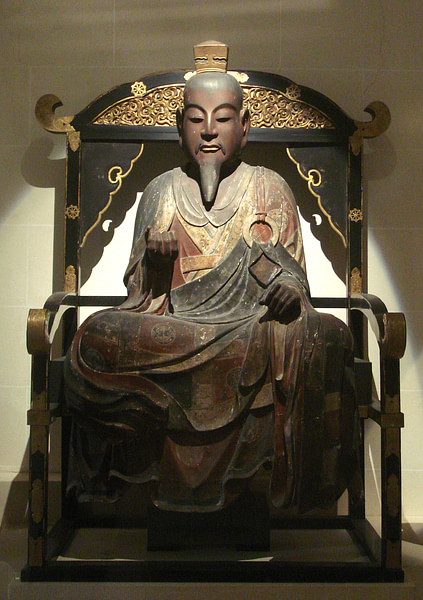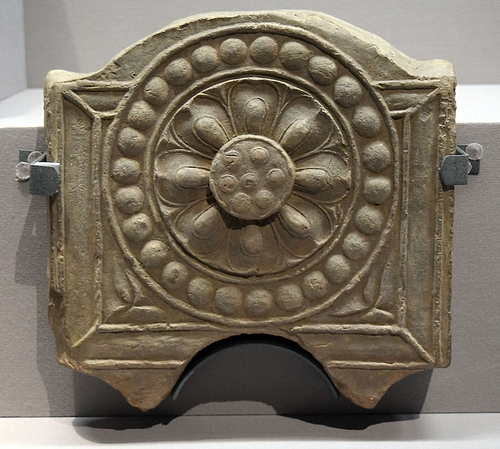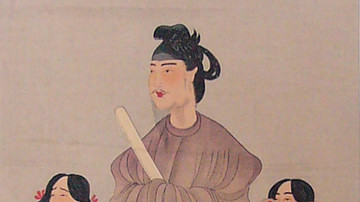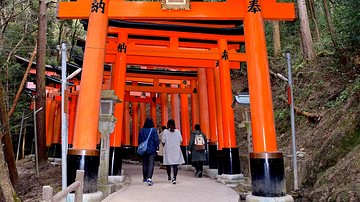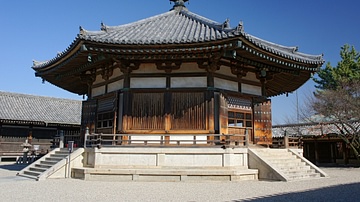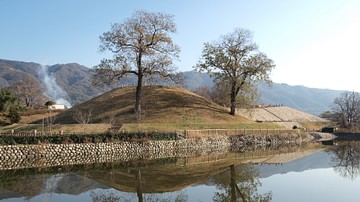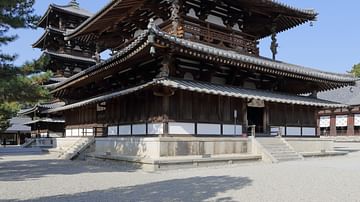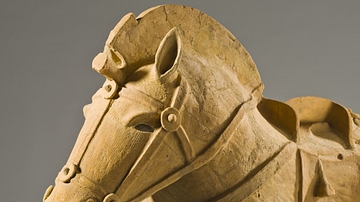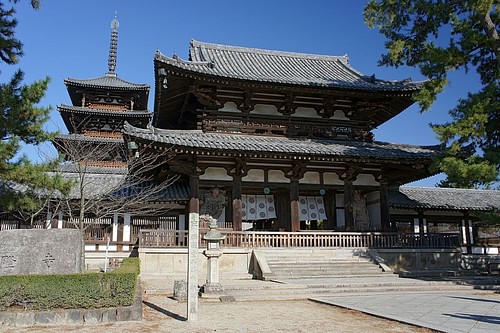
The Asuka Period (Asuka Jidai) of ancient Japan covers the period from 538 CE to 710 CE and, following on from the Kofun Period (c. 250-538 CE), so constitutes the latter part of the Yamato Period (c. 250-710 CE). For some scholars the period begins in 593 CE, and for art historians the end of the Asuka Period is dated to 645 CE. The period saw an increase in Japan's contact with other regional powers, the rule of such famous figures as Prince Shotoku, the establishment of the powerful Fujiwara clan, and the adoption of Buddhism. It was followed by the Nara Period (710-794 CE).
Historical Overview
The Asuka Period name derives from the capital at that time, Asuka, located in the northern Nara prefecture. In 645 CE the capital was moved to Naniwa, and between 694 and 710 CE it was at Fujiwarakyo. At the end of the period, in 710 CE, the capital moved yet again, this time to Heijokyo (aka Nara).
The period sees the first firmly established historical emperor (as opposed to legendary or mythical rulers), Emperor Kimmei, who was 29th in the imperial line and reigned from 531 or 539 CE to 571 CE. The most significant rulers of the period, though, were Empress Suiko and her regent Prince Shotoku. The prince was the second son of Emperor Yomei (r. 585-587 CE), and he ruled on behalf of Suiko from 594 CE until his death in 622 CE. Shotoku, also known as Umayado no Miko, is credited with reforming government, rooting out corruption, and diminishing the system of officials gaining office simply through inheritance, and encouraging greater ties with China. According to the Nihon Shoki ('Chronicle of Japan' and also known as the Nihongi), written in 720 CE, the people of Japan were distraught at the death of the good prince:
The sun and moon have lost their brightness; heaven and earth have crumbled to ruin: henceforward, in whom shall we put our trust? (Mason, 40)
The next major political event of the Asuka period occurred in 645 CE when the founder of the Fujiwara clan (Fujiwara-Shi), Fujiwara no Kamatari (then known as Nakatomi), staged a coup which took over power from the then dominant Soga clan (Soga-Shi). The Soga had Korean origins and they had held sway over government since 587 CE. The new government was then remodelled along Chinese lines in a series of reforms known as the Taika Reforms (Taika no Kaishin) in which land was nationalised, taxes were to be paid in kind instead of labour, social ranks were recategorised, civil service entrance examinations were introduced, law codes were written, and the absolute authority of the emperor established. Prince Naka no Oe became Emperor Tenjin, and Kamatari was made his senior minister and given the surname Fujiwara. This was the beginning of one of Japan's most powerful clans who would monopolise government during the Heian Period (794-1185 CE).
The Jinshin Incident of 671-672 CE was a short but bloody internal dispute amongst the ruling classes which disputed the successor following Emperor Tenji's death. In the aftermath, the new emperor Temmu (r. 672-686 CE) took the opportunity to prune the extended royal family so that only his descendants and those of his wife Jito (r. 686-697 CE) could claim any right to the imperial throne. In 685 CE, Temmu also appointed his own followers in key positions within the state bureaucracy, created a conscript army, and prohibited any other citizens from carrying arms. Fujiwarakyo was selected as the first proper Japanese capital which had a palace in the Chinese-style and streets laid out in a regular grid pattern. The very end of the period saw the introduction of Japan's first coinage, the Wado kaiho, in 708 CE.
Relations with China & Korea
During the Asuka period significant cultural relations were maintained with the Baekje (Paekche) kingdom of Korea, contact having already been established with the Korean peninsula from the 4th century CE, especially from the Gaya confederation of Korea. The advanced Baekje culture was exported via teachers, scholars, and artists travelling to Japan, and with them came elements of Chinese culture such as classic Confucian texts but also elements of Korean culture, for example, as seen in the wooden buildings constructed there by Korean architects. The exact relations between Korea and Japan in this period are controversial, but it does seem that Baekje officials occupied important positions in the Yamato government and may well have mixed with the imperial line, in particular, the Soga clan. Chinese influence was also seen in the drawing up of a constitution in 604 CE, the Seventeen Article Constitution (Jushichijo-kenpo), which centralised government and emphasised both Buddhist and Confucian principles, especially the importance of harmony (wa). Prince Shotoku is credited with composing the constitution.
Perhaps most significant of all, and certainly the most durable foreign cultural impact, was the introduction of Buddhism to Japan sometime in the 6th century CE, traditionally in 552 CE. It was officially adopted by Emperor Yomei and further encouraged by Prince Shotoku who built several temples, formed a body of artists to create Buddhist images, and who was himself a student of its teachings. Buddhism was generally welcomed by Japan's elite (excepting initial resistance from the pro-Shinto Mononobe and Nakatomi clans) as it helped raise Japan's cultural status as a developed nation in the eyes of their powerful neighbours Korea and China. Shotoku also sent official embassies to the Sui court in China from c. 607 CE and then throughout the 7th century CE.
Relations with Japan's neighbours were not always amicable. The Silla kingdom, a longtime rival of Baekje in the Korean peninsula, finally overran its neighbour in 660 CE with the help of a massive Chinese Tang naval force. A rebel Baekje force persuaded Japan to send 800 ships under the command of Abe no Hirafu to aid their attempt to regain control of their kingdom, but the joint force was defeated at the Battle of Baekgang (Hakusonko) at the mouth of the Geum/Paekchon River in 663 CE. The success of the Unified Silla Kingdom resulted in another wave of immigrants entering Japan from the collapsed Baekje and Goguryeo kingdoms.
Art & Architecture
The arts flourished in the Asuka Period and have given rise to an alternative name, the Suiko Period (552-645 CE) after Empress Suiko (r. 592-628 CE). Literature and music following Chinese models were actively promoted by the court and artists were given tax reliefs. Sculptors produced large numbers of Buddhist figures in wood and gilded bronze. Poems were composed which would find themselves in the Manyoshu or 'Collection of 10,000 Leaves,' which was compiled c. 760 CE, making it the earliest such anthology in Japanese literature.
During the reign of Shotoku 46 Buddhist monasteries and temples were built, the most important of which were the Shitennoji (593 CE), Hokoji (596 CE), and Horyuji. The latter was completed in 607 CE but burnt down c. 670 CE, after which it was rebuilt; it is the only surviving monastery from the Asuka Period in its original state. The complex, consisting of 48 listed buildings including a 5-storey pagoda, has the oldest wooden buildings in Japan.
This content was made possible with generous support from the Great Britain Sasakawa Foundation.
